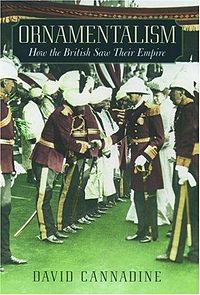- Ornamentalism
-
- This article refers to the book.For the architectural style see Ornamentalism (architecture)
Ornamentalism: How the British Saw Their Empire 
Author(s) David Cannadine Country United Kingdom Language English Genre(s) History Ornamentalism: How the British Saw Their Empire is a book by David Cannadine about British perceptions of the British Empire.[1] Cannadine argues that class, rank and status[2] were more important to the British Empire than race[3] The title of the work Ornamentalism is a direct reference to Edward Said's book Orientalism, which argues the existence of prejudiced outsider interpretations of the East, shaped by the attitudes of European imperialism in the 18th and 19th centuries.
Contents
Analysis
Peter J. Marshall argues that Cannadine makes two arguments in Ornamentalism:
- 1. "...the history of the British empire and the history of Britain itself are inseparable and must be studied as a seamless whole"[4]
- 2. "the high days of British imperialism, that is from about 1850 to about 1950, the history of the empire and that of Britain were brought together by a British commitment to reproduce overseas the kind of hierarchical society that, Cannadine believes, existed in Britain"[4]
Criticism
Ornamentalism has been criticised for underplaying the racist element of the civilising mission.[5]
See also
References
- ^ Richard Gott (2001-05-08). "Review: Ornamentalism by David Cannadine | Books". London: The Guardian. http://www.guardian.co.uk/books/2001/may/05/historybooks.socialsciences. Retrieved 2010-07-19.
- ^ "Project MUSE - Journal of Colonialism and Colonial History - Ornamentalism and Orientalism: Virtual Empires and the Politics of Knowledge". Muse.jhu.edu. http://muse.jhu.edu/login?uri=/journals/journal_of_colonialism_and_colonial_history/v003/3.1hansen.html. Retrieved 2010-07-19.
- ^ "Review-a-Day - Ornamentalism : How the British Saw Their Empire (02 Edition) by David Cannadine, reviewed by The New Republic Online - Powell's Books". Powells.com. 2001-10-11. http://www.powells.com/review/2001_10_11.html. Retrieved 2010-07-19.
- ^ a b Janet Hastings. "History in Focus: Empire Review Article on "Ornamentalism"". History.ac.uk. http://www.history.ac.uk/ihr/Focus/Empire/reviews/marshall2.html. Retrieved 2010-07-19.
- ^ Robert McCrum (2001-05-08). "Observer review: Ornamentalism by David Cannadine | Books | The Observer". London: Guardian. http://www.guardian.co.uk/books/2001/may/06/historybooks.artsandhumanities. Retrieved 2010-07-19.
External links
Categories:- 2001 books
- 21st-century history books
- History books about the British Empire
- Books by David Cannadine
- Postcolonial literature
- British Empire
Wikimedia Foundation. 2010.
